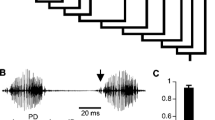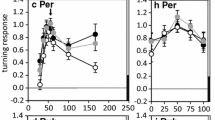Summary
The calling song ofTeleogryllus oceanicus consists of a chirp section and a trill section. We tested the phonotactic attractiveness to femaleT. oceanicus of the chirp and trill components of the song by permitting crickets to choose between synthetic song models in two-choice behavioral assays.
In a flight phonotaxis assay tethered flying crickets were simultaneously offered two different song models from loudspeakers located to the left and right. Song preference was indicated by postural changes associated with steering attempts. In the flight assay females preferred a song derived from the chirp component of the normal song pattern to one derived from the trill component (Figs. 3, 4A). They also preferred a song which consisted of 100% chirp over the normal song pattern, which is only 16% chirp (Fig. 6A). And, they preferred the normal song pattern to a chirp-free, trill-derived model (Fig. 5A). Two other song models, in which the percent of time occupied by the chirp was approximately twice normal, were also preferred to the normal pattern (Fig. 7). Thus, the chirp section of the song was more attractive than the trill section. Although the two components differed in their relative attractiveness, either was preferred to a heterospecific song model (Figs. 8A, 9A).
Five of these experiments were also performed using a walking phonotaxis assay. Crickets were released in an arena in which two loudspeakers broadcast different song models. Song preferences were indicated by the relative number of times each loudspeaker was approached. For three experiments (Figs. 4, 5, 8) the results obtained with the walking assay were qualitatively similar to those obtained with the flight assay. In two experiments there was no apparent discrimination of the songs in the walking assay, although the songs were discriminated in the flight assay (Figs. 6, 9). Possible reasons for the differences observed between the assays are discussed.
Similar content being viewed by others
References
Alexander RD (1961) Aggressiveness, territoriality, and sexual behavior in field crickets (Orthoptera: Gryllidae). Behaviour 17:130–223
Alexander RD (1962) Evolutionary change in cricket acoustical communication. Evolution 16:443–467
Bailey WJ, Thomson P (1977) Acoustic orientation in the cricketTeleogryllus oceanicus (Le Guillou). J Exp Biol 67:71–75
Bentley DR, Hoy RR (1972) Genetic control of the neuronal network generating cricket (Teleogryllus Gryllus) song patterns. Anim Behav 20:478–492
Cade W (1979) The evolution of alternative male reproductive strategies in field crickets. In: Blum MS, Blum NA (eds) Sexual selection and reproductive competition in insects. Academic Press, New York, pp 343–379
Campbell DJ, Shipp E (1979) Regulation of spatial pattern in populations of the field cricketTeleogryllus commodus (Walker). Z Tierpsychol 51:260–268
Emlen ST (1972) An experimental analysis of the parameters of bird song eliciting species recognition. Behaviour 41:130–171
Falls JB (1963) Properties of bird song eliciting responses from territorial males. In: Sibley CG (ed) Proceedings XIII International Ornithological Congress. American Ornithologists' Union, Baton Rouge, pp 259–271
Heiligenberg W (1966) The stimulation of territorial singing in house crickets (Acheta domesticus). Z Vergl Physiol 53:114–129
Heiligenberg W (1969) The effect of stimulus chirps on a cricket's chirping (Acheta domesticus). Z Vergl Physiol 65:70–97
Hill KG (1974) Carrier frequency as a factor in phonotactic behaviour of female crickets (Teleogryllus commodus). J Comp Physiol 93:7–18
Hill KG, Loftus-Hills JJ, Gartside DF (1972) Pre-mating isolation between the Australian field cricketsTeleogryllus commodus andT. oceanicus (Orthoptera: Gryllidae). Aust J Zool 20:153–163
Hoy RR, Paul RC (1973) Genetic control of song specificity in crickets. Science 180:82–83
King AP, West MJ (1977) Species identification in the North American cowbird: appropriate responses to abnormal song. Science 195:1002–1004
Marler P (1960) Bird songs and mate selection. In: Lanyon WE, Tavolga WN (eds) Animal sounds and communication. American Institute of Biological Sciences, Washington, DC, pp 348–367
Moiseff A, Pollack GS, Hoy RR (1978) Steering responses of flying crickets to sound and ultrasound: mate attraction and predator avoidance. Proc Natl Acad Sci USA 75:4052–4056
Morris GK, Kerr GE, Gwynne DT (1975) Calling song function in the bog katydid,Metrioptera sphagnorum (F. Walker) (Orthoptera, Tettigoniidae): female phonotaxis to normal and altered song. Z Tierpsychol 37:502–514
Murphey RK, Zaretsky MD (1972) Orientation to calling song by female crickets,Scapsipedus marginatus (Gryllidae). J Exp Biol 56:335–352
Narins PM, Capranica RR (1976) Sexual differences in the auditory system of the tree frogEleutherodactylus coqui. Science 192:378–380
Pollack GS, Hoy RR (1979) Temporal pattern as a cue for species- specific calling song recognition in crickets. Science 204:429–432
Popov AV, Shuvalov VF (1977) Phonotactic behavior of crickets. J Comp Physiol 119:111–126
Regen J (1913) Über die Anlockung des Weibchens vonGryllus campestris L. durch telephonisch übertragene Stridulationslaute des Männchens. Pflügers Arch 155:193–200
Sandeman DC (1968) A sensitive position measuring device for biological systems. Comp Biochem Physiol 24:635–638
Sokal R, Rohlf JF (1969) Biometry. Freeman, San Francisco
Tomioka K, Yamaguchi T (1980) Steering responses of adult and nymphal crickets to light, with special reference to the head rolling movement. J Insect Physiol 26:47–57
Ulagaraj SM, Walker TJ (1973) Phonotaxis of crickets in flight: attraction of male and female crickets to male calling songs. Science 182:1278–1279
Ulagaraj SM, Walker TJ (1975) Response of flying mole crickets to three parameters of synthetic songs broadcast outdoors. Nature 253:530–532
Walker TJ (1957) Specificity in the response of female tree crickets (Orthoptera, Gryllidae, Oecanthinae) to calling songs of the males. Ann Entomol Soc Am 50:626–636
Wendler G, Dambach M, Schmitz B, Scharstein H (1980) Analysis of the acoustic orientation behavior in crickets (Gryllus campestris L.). Naturwissenschaften 67:99–101
Wunderle JM (1979) Components of song used for species recognition in the common yellowthroat. Anim Behav 27:982–996
Zaretsky MD (1972) Specificity of the calling song and short term changes in the phonotactic response by female cricketsScapsipedus marginatus (Gryllidae). J Comp Physiol 79:153–172
Author information
Authors and Affiliations
Additional information
This work was supported by National Institutes of Health Grant NS-11630-04 to R.H. and by a National Institutes of Health postdoctoral fellowship and a McGill University Graduate Faculty research grant to G.S.P. We thank R. Chase, W. Cade and M. Nelson for their comments on the manuscript, and A. Moiseff and B. Land for help with electronics.
Rights and permissions
About this article
Cite this article
Pollack, G.S., Hoy, R. Phonotaxis to individual rhythmic components of a complex cricket calling song. J. Comp. Physiol. 144, 367–373 (1981). https://doi.org/10.1007/BF00612568
Accepted:
Issue Date:
DOI: https://doi.org/10.1007/BF00612568




